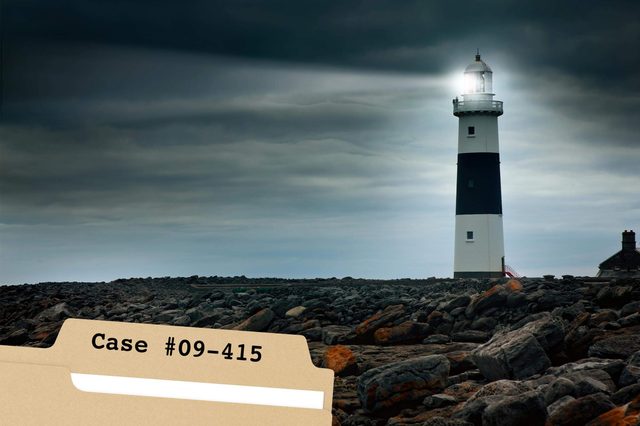Get ready to have the hair on the back of your neck stand on end because these unexplainable mysteries are among the most chilling ever

19 of the Strangest Unsolved Mysteries of All Time


The incident at Dyatlov Pass
On Feb. 1, 1959, nine ski-hikers died mysteriously in the mountains of what is now Russia. The night of the incident, the group set up camp on a slope, enjoyed dinner and prepared for sleep—but something went catastrophically wrong. The group never returned.
On Feb. 26, searchers found the hikers’ abandoned tent, which had been ripped open from the inside. They also discovered footprints left by the group—some wearing socks, some wearing a single shoe, some barefoot. The prints continued to the edge of a nearby wood, which is where the first two bodies were found, shoeless and wearing only underwear. At first, the scene suggested death by hypothermia. But after medical examiners evaluated the bodies, including the other seven discovered later, hypothermia no longer made sense. In fact, the evidence made no sense at all. One body had signs of a blunt force trauma consistent with a brutal assault. Another had third-degree burns. One victim had been vomiting blood. One was missing a tongue. Some of their clothing was radioactive.
Possible explanations included KGB interference, drug overdose, UFOs, gravity anomalies and the Russian version of the Yeti. Recently, a documentary filmmaker presented a different theory—a terrifying but real phenomenon called “infrasound,” in which the wind interacts with the topography to create a barely audible hum that can induce intense nausea, panic, dread, chills, nervousness, raised heart rate and breathing difficulties.
The only real consensus is that whatever happened involved an overwhelming and possibly “inhuman force.”

Sickening noises
In December 2016, a CIA officer checked in to the American Embassy’s health office in Havana suffering from nausea, headache and dizziness. Days later, two more CIA officers reported similar ailments. By late 2018, the number grew to 26 Americans and 14 Canadian diplomats with roughly the same weird symptoms, ranging from hearing loss to nosebleeds. All the victims said that the symptoms were related to a strange noise they’d heard at their homes or hotel rooms. One noted that the noise was high-pitched. Another described “a beam of sound, pointed into their rooms.” Some said that the noise resembled marbles rolling inside a large funnel.
While the cause of these reported brain injuries was still a mystery, the fallout was clear. In October 2017, the Americans removed 60% of their diplomats from Cuba and expelled 15 Cuban diplomats from Washington, D.C. The illnesses confounded medical experts. Doctors at the University of Pennsylvania who examined some of the victims diagnosed concussion-like symptoms but didn’t find signs of concussions. You might be thinking: The Cuban government was up to something, right? The Cubans vehemently denied they were responsible. Many American investigators believed them.
Recordings of the sounds only added to the confusion. Two scientists believed the recordings were of lovelorn male crickets. One of the experts, Alexander Stubbs of the University of California, Berkeley, said the insects are incredibly loud. “You can hear them from inside a diesel truck going 40 miles an hour on the highway.” Still, scientists had no idea how these sounds could lead to human illness, and they couldn’t explain why other people who lived near the diplomats weren’t affected.
Maybe it was just nerves. “Cuba is a high-threat, high-stress post,” a former embassy official told propublica.org. Diplomats are warned that “there will be surveillance. There will be listening devices in your house, probably in your car. For some people, that puts them in a high-stress mentality, in a threat-anticipation mode.”
True—but then how to explain what happened in China? In May 2018, an American posted in the consulate in Guangzhou was diagnosed with the very same mystery illness. Ultimately, 15 Americans were evacuated.
In 2020, a report from the National Academies of Sciences, Engineering and Medicine concluded that the most probable cause was “radiofrequency energy, a type of radiation that includes microwaves.” Meanwhile, a 2023 intelligence community assessment found that the injuries were likely “tied to previous injuries, stress, environmental concerns and factors such as group psychology, in which illness symptoms reported by one individual in a community can spread serially among its members.”
And in 2024, two studies by the National Institutes of Health compared more than 80 affected people with a healthy comparison group. The results, published in the Journal of the American Medical Association, showed “no clinical signs or brain image indications to explain those widely varied symptoms.” Yet attorney Mark Zaid, who represents current and past federal officials and their family members seeking continued medical treatment for Havana syndrome, believes that “the government is knowingly weaponizing the lack of science that exists in this area and intentionally hiding behind the classification wall where much of the evidence that contradicts the results exists.”
The mysterious sounds may well be the opening shots in a new kind of cold war.

Ghost ship: The Mary Celeste
On Dec. 4, 1872, a British American ship called the Mary Celeste was found empty and adrift in the Atlantic. It was seaworthy and had its cargo fully intact, except for a lifeboat, which seemingly had been boarded in an orderly fashion. But why? Like many strange ocean mysteries, we may never know the truth because no one on board was ever heard from again.
In November 1872, the Mary Celeste set sail from New York bound for Genoa, Italy. She was manned by Captain Benjamin Briggs and seven crew members and also carried Briggs’s wife and their 2-year-old daughter. The ship had plenty of supplies, including luxuries like a sewing machine and an upright piano. Experts agree that to abandon a seaworthy ship, something extraordinary and alarming must have happened. However, the last entry on the ship’s daily log revealed nothing unusual. And everything inside the ship appeared to be in order.
Theories over the years have included mutiny, pirate attack and an assault by a giant octopus or sea monster. In recent years, scientists have proposed the theory that fumes from alcohol on board caused an explosion that, as a result of a scientific anomaly, did not leave behind signs of burning—but was terrifying enough that Briggs ordered everyone into the lifeboat.

Who (and where) is D.B. Cooper?
On Nov. 24, 1971, Dan Cooper was a passenger on Northwest Airlines Flight 305, from Portland to Seattle—a 30-minute flight. He was described by passengers and flight attendants as a man in his mid-40s, wearing a dark suit, black tie with a mother-of-pearl tie clip, and a neatly pressed white collared shirt. He took his seat, lit a cigarette and politely ordered a bourbon and soda. Shortly after takeoff, he handed a 23-year-old flight attendant a note that reportedly said: “Miss, I have a bomb and would like you to sit by me.”
His demands were for $200,000 (worth $1.5 million today), four parachutes and a fuel truck standing by in Seattle to refuel the plane on arrival. The flight attendant brought the demands to the captain. The airline’s president authorized full cooperation. The other passengers had no idea what was happening; they were told that the landing was delayed due to mechanical difficulties.
When the plane landed, an airline employee delivered a cash-filled knapsack and parachutes, and Cooper allowed all passengers and two flight attendants to leave the plane. During refueling, Cooper outlined his plan to the crew: a southeasterly course toward Mexico with one further refueling stop in Nevada. Two hours later, the plane took off. When it landed in Reno, Cooper was no longer on the plane. Cooper (whom the media mistakenly referred to as “D.B. Cooper”) was never seen or heard from again. No parachute was found, and the ransom money was never used.
But in 1980, a young boy on vacation with his family near the Columbia River in Oregon found several packets of the ransom money (identifiable by serial number). That surprise discovery led to an intense search of the area for Cooper (or his remains). There was no sign of him. The FBI closed its case in 2016.
But that wasn’t the last chapter of this mystery: In 2024, two siblings came forward claiming their father, Richard Floyd McCoy Jr., was actually D.B. Cooper. McCoy Jr., a military-trained parachutist, was convicted for an eerily similar hijacking in April 1972 over Provo, Utah (he was sentenced to 45 years in prison). He died two years later. While he is the most likely suspect, there is still no definitive proof that he pulled off the original heist.

Living statues
From 1917 to 1928, half a million people were afflicted with a ghastly condition that could be part of the plotline of a horror film. The victims—very much alive and conscious—found themselves in inexplicably frozen states, their static bodies prisons for their minds.
Encephalitis lethargica (EL), aka “the sleeping sickness,” first appeared in Europe and quickly spread around the world, reaching epidemic levels in North America, Europe and India by 1919. About a third of those stricken with the illness died. Of the survivors, nearly half eventually found themselves unable to physically interact with the world around them, all the while fully aware of their surroundings. Though occasionally capable of limited speech, eye motion and even laughter, they generally appeared as living statues—totally motionless for hours, days, weeks or years.
The cause is unknown, but one theory is brain inflammation triggered by a rare strain of streptococcus, the bacteria responsible for many sore throats each year. Science’s best guess is that the bacteria mutated, provoking the immune system to attack the brain, leaving the victim helpless.
None of this explains why the illness disappeared only to resurface sporadically, be it in Europe in the 1950s or in China 15 years ago when a 12-year-old girl was hospitalized for five weeks with the disease.
Are such occurrences the new normal, or are they signs that EL could be planning something bigger any day? A 2004 analysis of 20 patients with symptoms remarkably similar to EL concluded that whatever ailed them “is still prevalent.” As such, history’s so-called sleeping sickness remains the stuff of nightmares.

What is Area 51?
Area 51, in southern Nevada, is a U.S. military base. Its very existence was unconfirmed until 2013, when the CIA was obliged to respond to a Freedom of Information Act request from 2005. Based on historical evidence, it appears that Area 51 supports the development and testing of experimental aircraft and weapons. Public satellite images, such as those available on Google Maps, don’t provide insight. Even those with security clearance to visit Area 51 are transported there from Las Vegas via an airline called JANET, which reportedly stands for Joint Air Network for Employee Transportation, on an unmarked plane that turns off its transponder before descending.
The intense secrecy surrounding Area 51 has sparked rumors that the government uses it to house crashed UFOs and conduct lab tests on aliens. Other theories about what Area 51 is used for include: research on time travel, research on teleportation, meetings with extraterrestrials, development of a means for weather control and activities related to a shadowy one-world government.
Where these Area 51 secrets and theories come from is as much a mystery as Area 51, itself, but one thing is certain: People love a good conspiracy theory. At one point, conspiracy theorists believed the moon landing in 1969 had been faked. Hint: It wasn’t.

Roaming ruins
It’s not unusual to find junk in Brazil’s Guanabara Bay, but what Robert Marx unearthed there in 1982 was an unusual kind of foreign matter. In an underwater field the size of three tennis courts located 15 miles from shore lay the remains of some 200 Roman ceramic jars, a few fully intact. According to Marx, a professional treasure hunter, the jars appeared to be twin-handled amphorae that were used to transport goods such as grains and wine in the 3rd century. But how did they get there? The first Europeans didn’t reach Brazil until 1500.
The Romans, who traded primarily in Mediterranean port cities and the Middle East, had little incentive to invest in ships that could cross oceans. However, they did sail as far as India. Perhaps some untrained navigator lost his way in a storm. Or maybe mutineers steered the ship westward?
We may never know, nor are we likely to uncover more evidence. Brazil closed the Bay of Jars to further research in 1983 in an effort to deter looters. Marx claims the government didn’t want the area explored because finding Roman-era artifacts there would mean that, contrary to Brazil’s official history, the Portuguese were not the first Europeans to reach the country. And the truth? It’s resting 100 feet under the sea.

What is the Voynich Manuscript?
The Voynich Manuscript is a roughly 250-page book written in an entirely unknown language/writing system. It’s been carbon-dated back to the 1400s and includes illustrations of plants that don’t resemble any known species. Named for the Polish book dealer who purchased it in 1912, it is believed to have been intended as a medical text. Its first confirmed owner was Georg Baresch (1585–1662), an alchemist from Prague, who discovered it “taking up space uselessly in his library.” Baresch tried to investigate the manuscript’s origins, to no avail.
The manuscript changed hands for centuries until it was purchased by Voynich, who posited that it was authored by Albertus Magnus (an alchemist) or Roger Bacon (an early scientist). However, some believe that Voynich fabricated the manuscript and its history all by himself. Various other hoaxes have been proposed over the years. Of course, that wouldn’t explain the carbon-dating of the paper and ink. Centuries after its first (alleged) discovery, the Voynich Manuscript remains as impenetrable and inexplicable as ever.

Do the Pollock sisters prove reincarnation?
Roughly 33% of Americans believe in reincarnation. Although scientists tend to pooh-pooh the possibility, every once in a while, an unsolved mystery comes around that is so compelling and otherwise unexplainable that it gives even scientists pause. That is what we have in the story of the Pollack sisters.
In 1957, two young English sisters, Joanna Pollock, 11, and Jacqueline Pollock, 6, died in a tragic car accident. One year later, their mother gave birth to twins, Gillian and Jennifer. When the twins were old enough to talk, they began identifying and requesting toys that had belonged to their dead sisters, pointing out landmarks only their dead sisters would have known (such as a school they’d attended), and sometimes panicking upon seeing cars idling (“That car is coming to get us!” they reportedly shrieked on one occasion).
After the twins turned 5, these incidents became less frequent, and the girls went on to lead normal lives. Still, the story of the Pollock sisters made its way to Ian Stevenson, MD (1918–2007), a psychiatrist and professor at the University of Virginia who studied reincarnation. After investigating thousands of supposed cases, Dr. Stevenson wrote a book describing 14 of them he believed to have been real, including that of the Pollock sisters.

Where are the Sodder children?
Unexplainable mysteries involving children are always extra chilling. George and Jennie Sodder of West Virginia were forced to cope with not only the loss of five of their children but also with the mysterious circumstances surrounding that loss. After the Sodders’ home burned to the ground on the night before Christmas in 1945, five of the 10 Sodder children were still alive and accounted for. But what about the other five? They had vanished into thin air.
Notice how we don’t say “vanished into smoke”? That’s because there was zero physical evidence of the children in the ruins (virtually impossible from a scientific standpoint). And that wasn’t all that was off about the night’s events. Apparently, George tried to save his children, who he believed were trapped inside, by using a ladder he kept against the side of the house, but the ladder was missing. Also weird, the phone lines to the house were cut. A woman claimed to have seen all five missing children peering from a passing car while the fire was in progress. And a woman at a Charleston hotel said she had seen four of the five missing kids a week after the fire. “The children were accompanied by two women and two men, all of the Italian extraction,” she said in a statement. “I tried to talk to the children in a friendly manner, but the men appeared hostile … and wouldn’t allow it.”
The Sodder family theorized that the children had been kidnapped, perhaps in an attempt to extort money, or maybe in retaliation for George’s outspoken criticism of Mussolini and Italy’s fascist government (the Sodders were Italian immigrants). From the 1950s until Jennie Sodder’s death in the late 1980s, the Sodder family maintained a billboard on State Route 16, with pictures of the five vanished children, and offered a reward for information. The last (known) surviving Sodder child, Sylvia, died in 2021 at age 79. Up until the end, she didn’t believe her siblings perished in the fire.

What really happened to young Walter Collins?
In 2008, Clint Eastwood’s film Changeling reawakened interest in one of the most bizarre and tragic crime stories of the 1920s. In March 1928, single mom Christine Collins reported her 9-year-old son, Walter, missing from their home in Los Angeles. Five months later, the police brought “Walter” back to Christine, except it wasn’t Walter, and Christine knew it. But the L.A. police dismissed Christine’s concerns, going so far as to accuse her of terrible mothering and having her committed to a mental hospital.
The real Walter Collins was never found, and over time, authorities came to believe he was one of the victims of convicted child murderer Gordon Stewart Northcott, who was caught and executed in 1930. Northcott’s mother confessed to killing Walter and was sentenced to life in prison. Walter’s body was never found, so we don’t know for sure what happened, and this case remains one of those baffling unsolved crimes. Nobody ever figured out why the police were so invested in covering up the boy’s disappearance that they brought a different child back to Christine and tried to convince her that it was her missing son.

The disappearance of Paula Jean Welden
Paula Jean Welden, 18, was a sophomore at Bennington College on Dec. 1, 1946, the day she told her roommate, Elizabeth Parker, she was going for a long walk but failed to return. A search focused primarily on Vermont’s Long Trail (a 272-mile trail that cuts through the center of Vermont to the Canadian border), where local witnesses reported having seen her.
The trail yielded no clues, though, and soon, what the local newspaper Bennington Banner referred to as “tantalizing and unquestionably strange leads” began to materialize. These included claims by a Massachusetts waitress that she’d served an agitated young woman matching Paula’s description. Upon learning of this lead, Paula’s father disappeared for 36 hours, supposedly to follow this clue. After this strange move, her dad became a prime suspect in Paula’s disappearance. Soon, stories circulated that Paula’s home life was not nearly as idyllic as her parents had told the police. Apparently, Paula had not returned home for Thanksgiving the week prior, and she may have been distraught about a disagreement with her father. For his part, Paula’s father suggested Paula was distraught about a boy and perhaps that guy should have been a suspect.
Over the next decade, a local Bennington man twice bragged to friends that he knew where Paula’s body was buried. He was not able to lead the police to a body, though. With no body and no forensic clues, the case grew colder, and the theories grew stranger, including those linked to the paranormal. New England author and occult researcher Joseph Citro came up with the “Bennington Triangle” theory, which explained the disappearance as linked to a special “energy” that attracts outer-space visitors, who could have taken Paula with them back to their world.

The Flannan Isles Lighthouse disappearances
In 1900, three keepers of the Flannan Isles Lighthouse off the west coast of Scotland disappeared under the strangest of circumstances. The lighthouse was manned by a three-person team (Thomas Marshall, James Ducat and Donald McArthur), with a fourth man rotating in from shore. On Dec. 26, 1900, the relief keeper arrived to discover the lighthouse keepers gone. The only sign of anything amiss was an overturned chair near the kitchen table.
Records at the lighthouse showed that the men were there until the afternoon of Dec. 15, 11 days earlier. But no bodies were ever found. While an official investigation concluded that the men had probably gone out in a boat and got swept out to sea, that hasn’t stopped the endless speculation. Theories range from drownings to abduction by foreign spies to death by a giant sea monster or a ghost ship. Whatever happened back in December 1900 at the Flannan Isles Lighthouse, we may never know.

The bridge at Overtoun that calls dogs to their maker
The Overtoun Bridge—near Dumbarton, Scotland—seems to call dogs to leap to their death. Since the 1950s, some 50 canines have perished, and hundreds more have jumped but survived, reports Slate via its Atlas Obscura blog, with some even returning to leap again onto the rocks 50 feet below.
In terms of scientific truth, it is unlikely that dogs are capable of forming an intent to die. Yet something is luring the animals off that bridge, often from the very same spot on dry, sunny days. Many theories have surfaced, including that the bridge is haunted by a ghost. In 2010, the Scottish Society for the Prevention of Cruelty to Animals sent a representative to investigate these unexplainable mysteries. While they decided that most likely a mink or other mammal was marking the area below with an almost irresistible scent, they also admitted that the bridge had a “strange feeling.”
Whatever is causing this weird phenomenon, dog owners would be wise to take heed and keep their dogs on leashes.

The Big Grey Man
The Big Grey Man is a not-human creature said to haunt the summit and passes of the second-highest peak in Scotland, Ben Macdui. In the native Scottish tongue, the creature is known as Am Fear Liath Mòr. Like the Yeti of the Himalayas and Big Foot (also known as Sasquatch) of the American Pacific Northwest, the Big Grey Man has been seen only by a few eyewitnesses.
Those who have spotted the Big Grey Man describe the creature as extremely tall (over 10 feet) and human-like, with short hair, broad shoulders and long arms. Nearly all reported sightings include the sound of gravel crunching beneath footfalls. Scientists haven’t come up with an explanation for these encounters. One theory from psychologists is that the witnesses may have been in a state of physical and mental anguish from exhaustion and/or isolation.
For now, the Big Grey Man remains a true mystery, but if you go to Scotland, let us know if you run into the Big Grey Man.

The lost colony of Roanoke
In 1587, John White led a group from Britain to found an English colony. They settled on Roanoke Island, one of a chain of barrier islands now known as the Outer Banks of North Carolina. White left for more supplies, but on his return three years later, found the colony completely abandoned, with all houses and fortifications dismantled with care.
Before he’d left the colony, White had instructed the colonists that if they were taken by force, they were to carve a cross into a nearby tree, but there was no cross. The only clue was the word “Croatoan”—the name of a native tribe allied with the English—carved into a post. White assumed the colonists had moved to Croatoan Island (now known as Hatteras).
Future investigations turned up reports that the colonists had been slaughtered by the Powhatan tribe, but there is no archaeological evidence of this. A recent re-examination of the evidence indicates that if a massacre occurred, it was not of the Roanoke colonists but an earlier group of colonists. Other theories suggest the colonists and the Croatoans or other local tribes integrated, but no DNA evidence has positively identified any descendants of the colony.

The Circleville letters
In 1976, residents of Circleville, Ohio, began receiving hate mail that has wreaked havoc ever since. The letters, postmarked from Columbus, were invasive and accusatory, highlighting a supposed affair between school bus driver Mary Gillespie and the school superintendent. One letter addressed to Mary’s husband, Ron, threatened his life if he didn’t put a stop to the affair.
By 1977, the husband was dead, the result of a suspicious one-car crash that reportedly happened when he was on his way to confront the letter writer. When the sheriff ruled the death an accident, residents began receiving letters accusing the sheriff of a cover-up. The letters continued throughout the 1970s and early 1980s—and even after Ron’s sister’s husband, Paul Freshour, was convicted of writing the letters and attempting to murder Mary via a booby-trap-rigged pistol.
But even with Freshour in prison, the letters continued. He even received one himself. In 1994, the letters actually stopped when Freshour was released, and he maintained his innocence until his death in 2012. The true identity of the Circleville letter writer remains unknown. Some still believe it was Freshour, while others point to his ex-wife, Karen Sue. A few think Frehour took the rap to protect his son, Mark, who committed suicide in 2002. Others believe it was Mary all along, and that she used the letters to concoct and support the murder of her own husband.

The Tunguska event
On the morning of June 30, 1908, 830 square miles of forest and an estimated 80 million trees in Siberia, Russia, were flattened by what appeared to be a mysterious explosion. The phenomenon, known as the Tunguska event, has been classified by scientists as the largest “impact event”—which means a recordable impact between two astronomical objects, such as an asteroid and the Earth—in recorded history. Yet no “impact crater” was ever found, making it one of those strange science mysteries no one has solved. Scientists can only surmise what might have happened, which could be that an asteroid exploded over the Earth’s surface and its after-effects caused the destruction in Siberia.

The disappearance of Malaysian Airlines Flight 370
One of the most unsettling unsolved mysteries took place on March 8, 2014, when a Boeing 777 carrying 239 passengers and crew members took off from Malaysia at 12:41 a.m. local time en route to China … and seemingly vanished into thin air.
There were clues early on that something was off about the flight. Less than an hour after takeoff, the plane’s transponder was inexplicably switched off. Radar picked up Flight 370 making a major deviation from its flight plan. A satellite last detected the plane over the Indian Ocean at 8:11 a.m.
The multinational search effort was the largest in aviation history, costing an estimated $160 million and covering thousands of square miles of ocean. Over the next two years, 27 pieces of aircraft debris were recovered, many washing up on beaches in the region. But only three were confirmed to come from Flight 370. The prime minister of Malaysia has declined to comment other than to say that the aircraft disappeared over the Indian Ocean.
Theories include a hijacking gone wrong, a fire aboard the aircraft and even a meteor strike. But pilot-induced suicide is the most credible explanation. Investigators learned that less than a month before, the captain had flown a path on his home flight simulator that closely resembled that of the ill-fated plane.
Still, the true cause of the disappearance of Malaysian Airlines Flight 370 and the 239 people aboard remains one of the strangest unexplainable mysteries.
Editor’s note: This article is not connected to the Unsolved Mysteries television series.
Why trust us
At Reader’s Digest, we’re committed to producing high-quality content by writers with expertise and experience in their field in consultation with relevant, qualified experts. We rely on reputable primary sources, including government and professional organizations and academic institutions as well as our writers’ personal experiences where appropriate. We verify all facts and data, back them with credible sourcing and revisit them over time to ensure they remain accurate and up to date. Read more about our team, our contributors and our editorial policies.
Sources:
- Spiked: “Dyatlov Pass: A chilling mystery solved?”
- JAMA Network: “Neurological Manifestations Among U.S. Government Personnel Reporting Directional Audible and Sensory Phenomena in Havana, Cuba”
- The Washington Post: “Another diplomat was diagnosed with ‘Havana syndrome.’ Here’s what we know.”
- Scientific American: “People with ‘Havana Syndrome’ Show No Brain Damage or Medical Illness”
- Smithsonian Channel: “The True Story of the Mary Celeste”
- FBI: “D.B. Cooper Hijacking”
- Oxford Academic: “Encephalitis lethargica: 100 years after the epidemic”
- Hong Kong Journal of Paediatrics: “Encephalitis Lethargica in a Twelve-year-old Girl: The Response to Levodopa Therapy”
- People: “Did Romans Discover Brazil? Marine Archaeologist Robert Marx Is Diving to Find Out”
- The New Yorker: “The Unsolvable Mysteries of the Voynich Manuscript”
- Historic Mysteries: “Pollock Twins: Proof of Reincarnation?”
- Smithsonian Magazine: “The Children Who Went Up in Smoke”
- NPR: “Behind ‘Changeling,’ A Tale Too Strange For Fiction”
- Bennington Banner: “After 60 years, student’s fate remains a legendary mystery”
- Slate: “The Dog Suicide Bridge of Dunbartonshire”
- BBC: “Who or what is the Big Grey Man of Ben Macdui?”
- Smithsonian Magazine: “The Mystery of Roanoke Endures Yet Another Cruel Twist”
- NASA: “115 Years Ago: The Tunguska Asteroid Impact Event”
- USA Today: “MH370: ‘Inconceivable’ disappearance remains mystery 3 years later”
- Britannica: “Malaysia flight 370 disappearance”





















